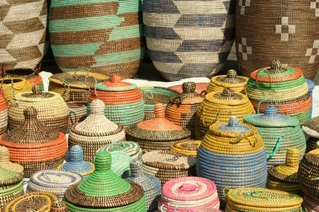|
African baskets are beautiful and practical at the same time.
African baskets are usually made of different materials like grass, vines, leaves, raffia, papyrus etc. The techniques used are often quite complex and are similar to the methods used in textile weaving. They are used for a variety of different purposes ranging from women carrying harvested crops from the fields, food from the market, goods for sale and also for storage. In West Africa in particular, baskets are made using the cross or checkerboard weaving techniques. In the central and southern parts of Africa, the coiling technique is commonly used. In some instances, basket weaving can be substituted for pottery. For example in Ethiopia, they use a very tight weave to make watertight containers that are used to collect, store and keep milk fresh. They also use a loose weave technique to make filters and sieves. In the hands of certain craftsmen, basket weaving can be a form of art. They use fibers of different natural or dyed colors to achieve various decorative designs such as animals figures or geometric patterns. The Tutsi people of Rwanda were very creative in producing beautiful baskets and containers using this technique. The Mangbetu women of Zaire made baskets to store their personal items such as jewelry. They also made buttock screens using leaves and basket weaving techniques. The Bwaka people of Zaire also made boxes using basket weaving methods much like the embroidery patterns found in textiles. These boxes were so elaborately designed and crafted that people of high society used them to keep their valuables. Basketry is not only used to make baskets, it is also used in the making of other objects such as mats, containers, stools and even shields. This just goes to showcase the ingenuity of the African people when it comes to creating items for everyday use which end up becoming pieces of art because of the high level of craftsmanship involved in their design and creation. Return From African Baskets To Homepage |




